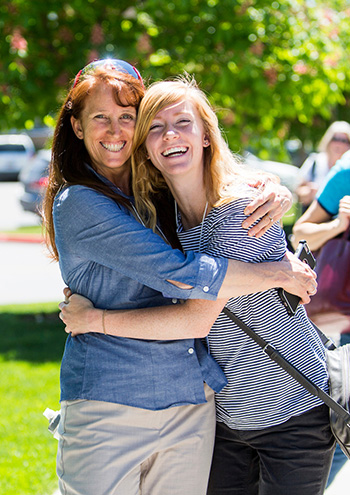Learning to Teach Like the Savior by Studying His Students
Contributed By Sarah Harris, Church News staff writer

J. B. Haws speaks on teaching in the Savior’s way during a breakout session of BYU Women’s Conference on Friday, May 5, 2017.
Article Highlights
- The recurring theme among all the Savior’s teachings was His love for His students.
- When we teach, our students should feel our love for them.
“I think we need teachers to stand up for people; that the classroom is safe when others are critical and maybe even demeaning; that the teacher stands up for something—even with their flaws.” —J. B. Haws, BYU assistant Church history and doctrine professor
Related Links
BYU assistant Church history and doctrine professor J. B. Haws gave a BYU Women’s Conference address on May 5 analyzing Christ’s teachings through the eyes of those He taught.
Show love for everyone you teach
According to Haws, the overarching theme the Savior’s students observed from His teachings was that He loved them. Haws gave specific examples of how those Christ taught might have felt His love.
Zacchaeus, who climbed a tree to see Jesus, or the woman who touched His clothes to be healed might have known the Savior loved them because He looked at them, Haws said.
“He looked at me: what does that mean? He noticed me in a crowd. He assessed my needs. He thought about how I was feeling,” Haws said. “The first thing I notice about Jesus as a teacher is He looks at me.”
Peter might have sensed the Savior's love when He let Peter bear his testimony, Haws said. He quoted Matthew 16, when Christ asked Peter, “Whom do men say that I the Son of Man am?” and then personalized the question by asking, “But whom say ye that I am?”
“I love that He asked a broad, open-ended question, and I think this is just a wonderful pattern for us,” Haws said. “I think how often we could do something similar, that we could let students bear their testimony.”
Adapt lessons to each situation
Haws said that Peter might also say about Christ’s teaching, “He reproved me betimes with sharpness.” This can be a good pattern to follow, Haws said, when we follow spiritual promptings and reprove in a way that would allow us to bless and heal others immediately afterward, just as the Savior when He cleansed the temple.
“I think we really bless students, our children, and the people we love when we reprove betimes with sharpness when moved upon by the Holy Ghost,” Haws said.

Women gather in the Marriott Center on the Provo campus for the opening session of BYU Women’s Conference on Thursday, May 4. Photo by Nate Edwards, BYU Photo.

Women walk across the BYU campus during the annual BYU Women’s Conference cosponsored by the Relief Society on Friday, May 5. Photo by Aislynn Edwards, BYU Photo.
The Pharisees in Luke 10 might have said about the Savior's teachings, “He responded to my sarcasm, my challenging question, my desire to catch Him, with a story,” Haws said. This same type of student might also notice the Savior taught true doctrine but didn't necessarily give a specific application along with it.
“I think that’s really beautiful because I think that’s the place where we allow the Spirit, as the true teacher, to come in and work on individual hearts,” Haws said. “We teach doctrine but allow the Spirit to work on personal application.”
Give students time to think
Jesus also gave His students time to think, Haws said, citing the example of the rich young ruler in the scriptures.
“I think it’s really significant that Jesus didn’t run after him in the account; didn’t say, ‘Wait, I have one more thing to say’ or ‘You really need to stop and listen.’ He allowed him time to think,” Haws said. “There’s something significant about the Savior’s patience.”
The Savior was also a great teacher because He didn't just judge His students on who He saw they were at that moment but took into consideration the unseen things about them, Haws said.
“I think as a teacher, I want to look and not judge only by the things that are true, the things that are so easy to see; I want to see something else,” he said.
Perceive the needs of students
Mary and Martha might have said, “He wept with me” of their experience being Jesus’s students, Haws said. And the two travelers on the road to Emmaus might mention how Jesus taught them to study the scriptures more carefully.
The Savior’s student in Luke 7, the “sinner” who anointed and kissed His feet, might say, “You stood up for me, even with my flaws,” Haws said.
“I think we need teachers to stand up for people; that the classroom is safe when others are critical and maybe even demeaning; that the teacher stands up for something—even with their flaws,” he said.
Haws said the Nephites and Lamanites in 3 Nephi might have said they sensed the Savior’s love when “His countenance smiled upon them.”
“What a great way to think of God, and Jesus in the express image of the Father, and think of Them that way: jovial, lively, good-natured,” Haws said. “I think students must notice that about Jesus.”
Haws said teachers can reflect Christ’s light by praying to be filled with charity for their students.
“What we can do is we can pray with all the energy of heart that we’re filled with this love, and then we can try to be true followers of His Son, Jesus Christ,” he said.
